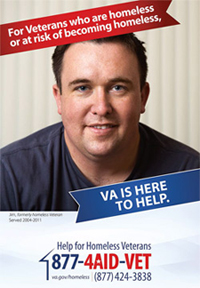Veterans' Healthy Living, Summer 2014
Homeless Veteran Numbers: When UP Means DOWN
In 2009, President Barack Obama and former VA Secretary Eric K. Shinseki announced the goal of ending Veteran homelessness by the end of 2015. How are we doing?
When you hear that the number of homeless Veterans has decreased, you might think that is good news. Kevin Casey, Network Homeless Coordinator, says that's only partially true.
"VISN 1 showed 169 unsheltered Veterans at the end of fiscal year 2013. That sounds like an improvement compared to 223 Veterans in 2007. While we've made a great deal of headway, the numbers can be confusing because we're actually doing more than ever to find homeless Veterans or those at risk of homelessness, which can make the numbers go up."
 Perhaps a better way to look at it, suggests Casey, is to consider the number of Veterans taken off the street. "Rather than counting the number still out there," he says, "we look at the number we've housed, prevented from becoming homeless, or intervened with in some way. For example, in New England, we have 2,942 HUD-VASH vouchers right now. Of those, 2,622 are issued—meaning the voucher has helped that many otherwise homeless Veterans."
Perhaps a better way to look at it, suggests Casey, is to consider the number of Veterans taken off the street. "Rather than counting the number still out there," he says, "we look at the number we've housed, prevented from becoming homeless, or intervened with in some way. For example, in New England, we have 2,942 HUD-VASH vouchers right now. Of those, 2,622 are issued—meaning the voucher has helped that many otherwise homeless Veterans."
Some funding for homeless initiatives is based on the projected number of homeless Veterans, but accurately counting homeless Veterans— particularly during winter in New England—can be a challenge. Most seek respite indoors during winter, and those who can will flee to warmer locales. Also, trying to locate homeless Veterans in rural environments can be difficult. Thus, the count
is not the most accurate assessment of the number of homeless, and it does not truly represent the progress VA has made in sheltering Veterans.
Still, Casey believes VA has made significant improvements nationwide at improving homelessness since 2009. "By 2015," he says, "we will have made an impact because we've established some best practices, and we've learned how to rapidly house Veterans through Supportive Services for Veteran Families (SSVF)." SSVF helps prevent at-risk Veterans from becoming homeless and rapidly re-houses those just evicted by providing eligible Veterans families case management services and assistance to obtain VA and other benefits—like childcare, legal, financial planning, and transportation, among others. Nationally, nearly 90 percent of those discharged from SSVF have found permanent housing.
In VISN1, some funds are used for "safe haven" beds reserved for Veterans with a history of substance abuse. Casey says these beds are important because it provides a place for Veterans who aren't sober.
If you or someone you know needs more information about homeless Veteran programs, please call 1-877-4AID-VET (1-877-424-3838) or go to http://www.va.gov/homeless/.
RBPS | Going Green | Improving Access | Homeless Veterans | Outreach Efforts
















